University Economics Assignment: ECO10250, Decision Making, Sem 1
VerifiedAdded on 2022/10/11
|12
|2172
|19
Homework Assignment
AI Summary
This economics assignment solution provides a comprehensive analysis of various economic concepts. It begins with an examination of Joan's production possibility curve, exploring increasing and constant opportunity costs, and efficient and inefficient outcomes. The assignment then delves into supply and demand dynamics, illustrating shifts in curves due to changes in production costs and the impact of government price controls. Elasticity of demand is also explored through calculations and examples of elastic, inelastic, and highly elastic goods, including an analysis of demerit goods. Further, the assignment presents a detailed breakdown of a firm's costs, revenues, and profit maximization in both the short run and long run, including graphical representations. Finally, the assignment concludes with an analysis of the Australian banking industry's market structure, comparing it to perfect competition and monopoly models and discussing its implications for consumers and social welfare.
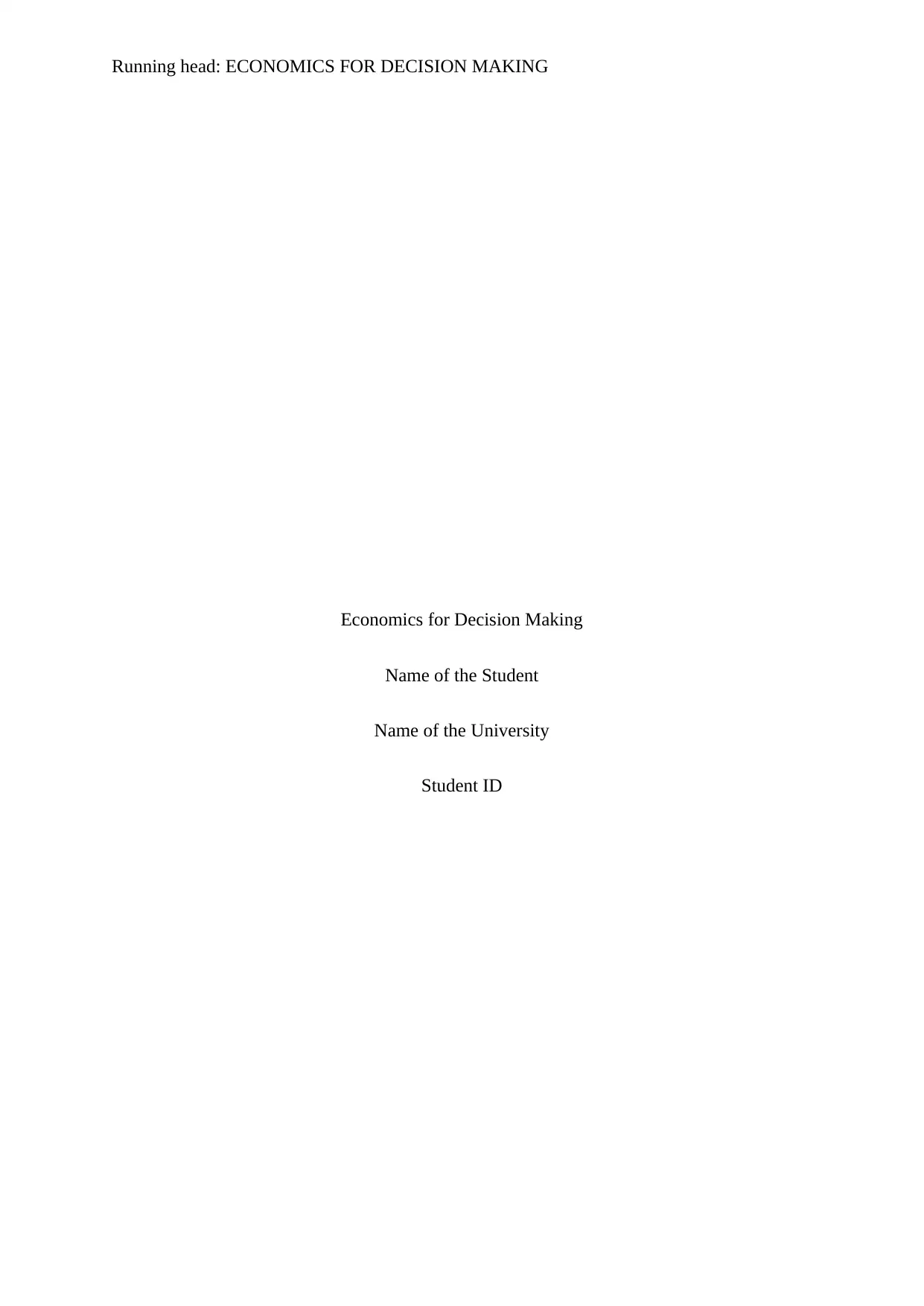
Running head: ECONOMICS FOR DECISION MAKING
Economics for Decision Making
Name of the Student
Name of the University
Student ID
Economics for Decision Making
Name of the Student
Name of the University
Student ID
Paraphrase This Document
Need a fresh take? Get an instant paraphrase of this document with our AI Paraphraser
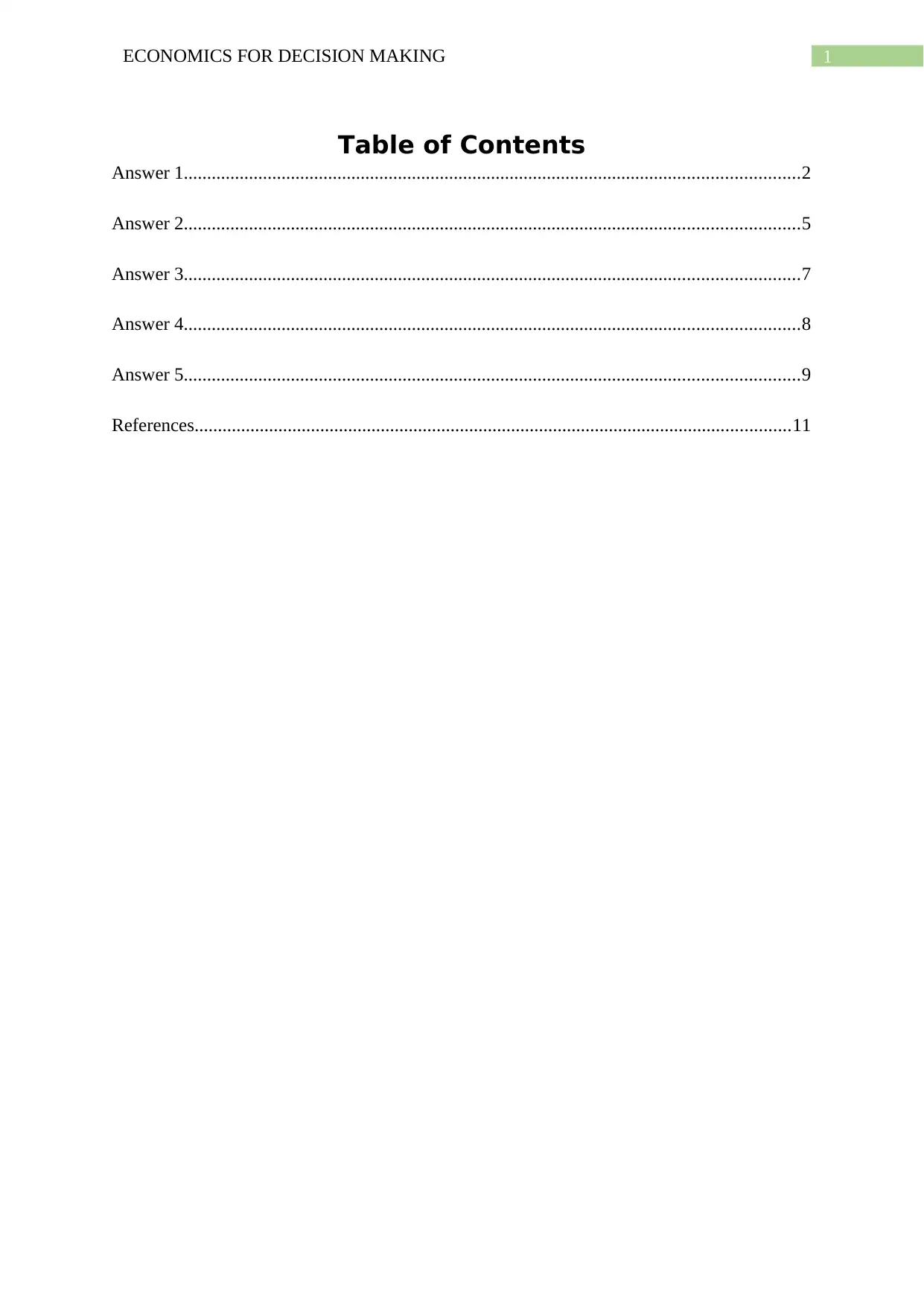
1ECONOMICS FOR DECISION MAKING
Table of Contents
Answer 1....................................................................................................................................2
Answer 2....................................................................................................................................5
Answer 3....................................................................................................................................7
Answer 4....................................................................................................................................8
Answer 5....................................................................................................................................9
References................................................................................................................................11
Table of Contents
Answer 1....................................................................................................................................2
Answer 2....................................................................................................................................5
Answer 3....................................................................................................................................7
Answer 4....................................................................................................................................8
Answer 5....................................................................................................................................9
References................................................................................................................................11
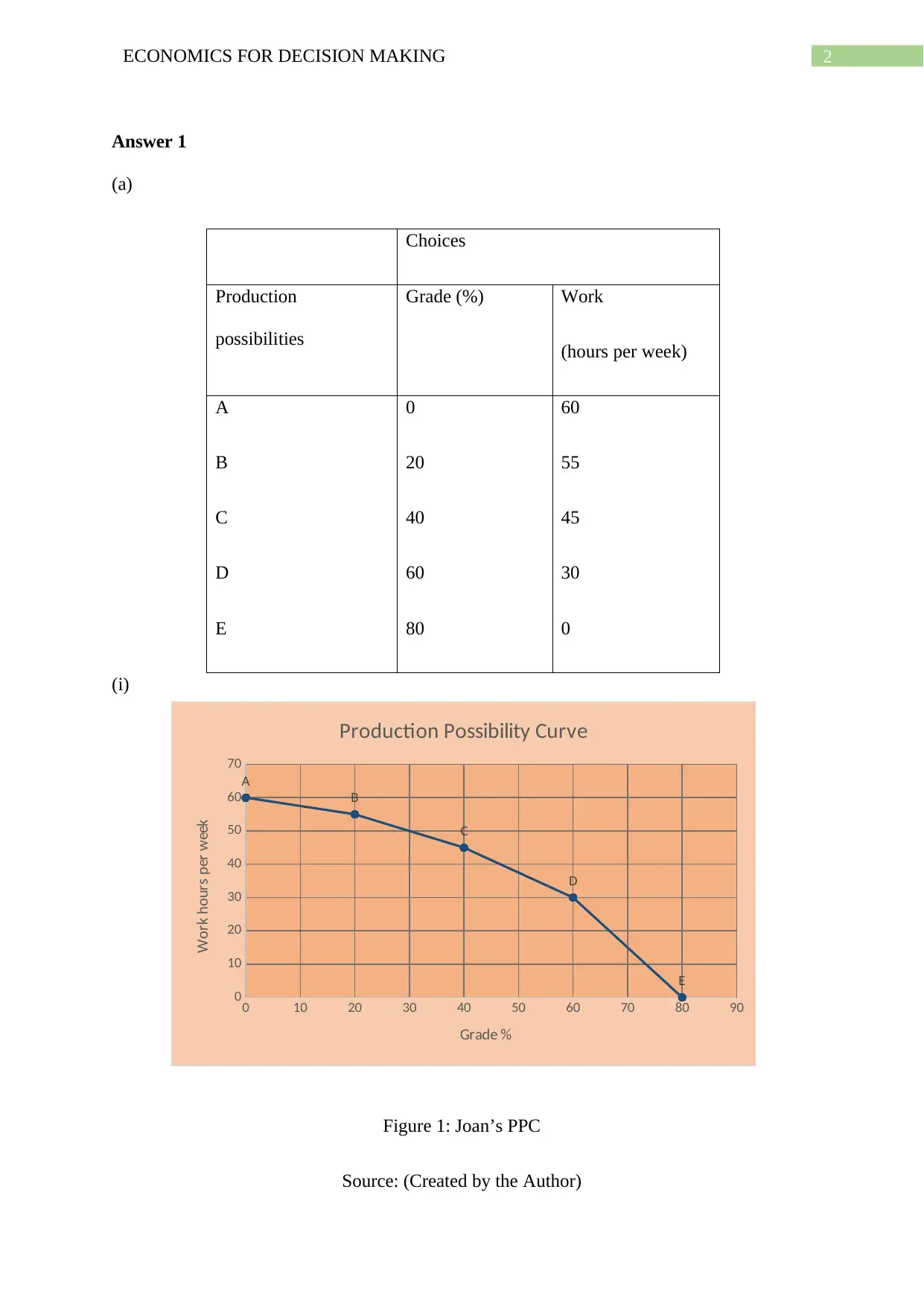
2ECONOMICS FOR DECISION MAKING
Answer 1
(a)
Choices
Production
possibilities
Grade (%) Work
(hours per week)
A
B
C
D
E
0
20
40
60
80
60
55
45
30
0
(i)
Figure 1: Joan’s PPC
Source: (Created by the Author)
0 10 20 30 40 50 60 70 80 90
0
10
20
30
40
50
60
70
A
B
C
D
E
Production Possibility Curve
Grade %
Work hours per week
Answer 1
(a)
Choices
Production
possibilities
Grade (%) Work
(hours per week)
A
B
C
D
E
0
20
40
60
80
60
55
45
30
0
(i)
Figure 1: Joan’s PPC
Source: (Created by the Author)
0 10 20 30 40 50 60 70 80 90
0
10
20
30
40
50
60
70
A
B
C
D
E
Production Possibility Curve
Grade %
Work hours per week
⊘ This is a preview!⊘
Do you want full access?
Subscribe today to unlock all pages.

Trusted by 1+ million students worldwide
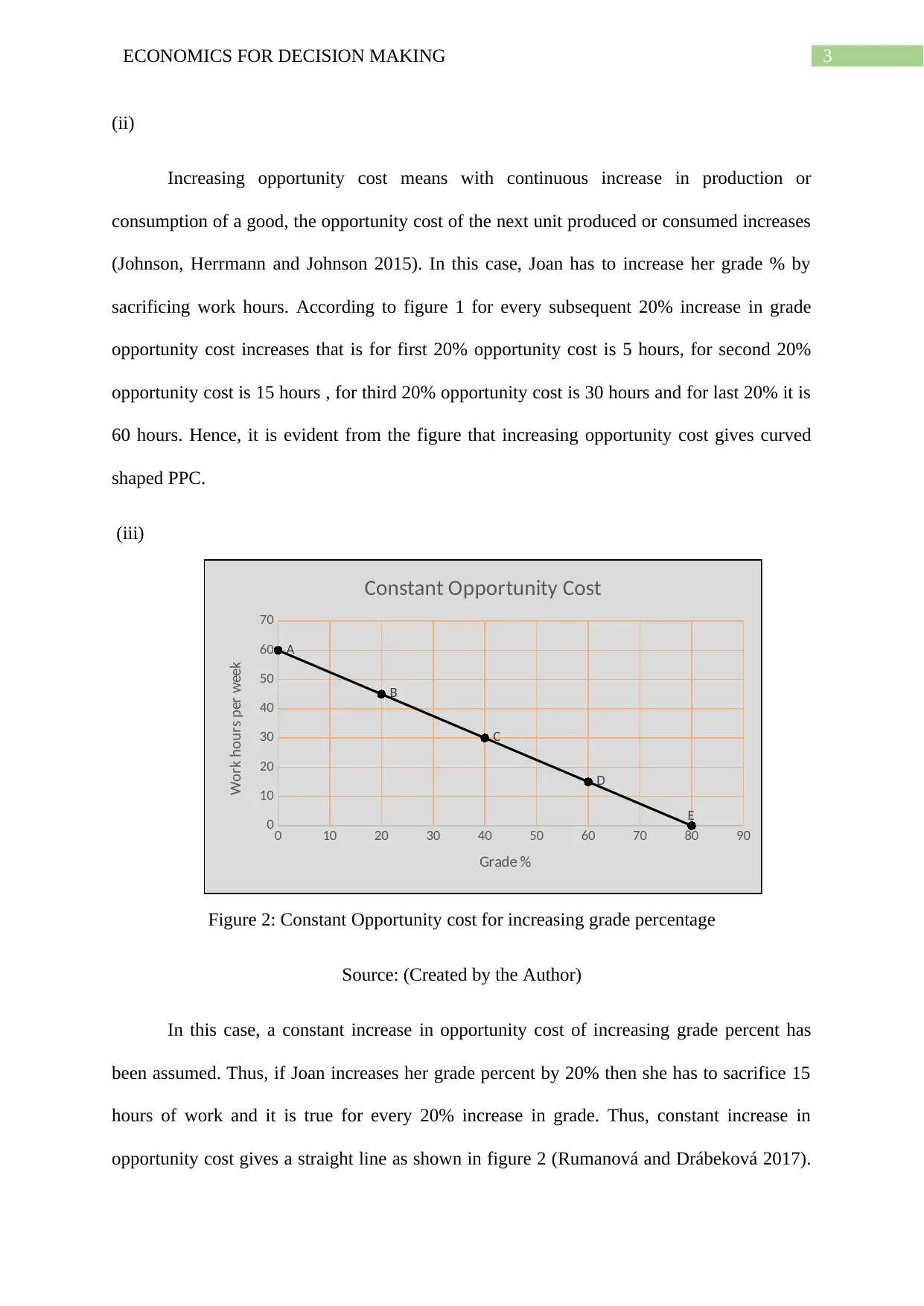
3ECONOMICS FOR DECISION MAKING
(ii)
Increasing opportunity cost means with continuous increase in production or
consumption of a good, the opportunity cost of the next unit produced or consumed increases
(Johnson, Herrmann and Johnson 2015). In this case, Joan has to increase her grade % by
sacrificing work hours. According to figure 1 for every subsequent 20% increase in grade
opportunity cost increases that is for first 20% opportunity cost is 5 hours, for second 20%
opportunity cost is 15 hours , for third 20% opportunity cost is 30 hours and for last 20% it is
60 hours. Hence, it is evident from the figure that increasing opportunity cost gives curved
shaped PPC.
(iii)
Figure 2: Constant Opportunity cost for increasing grade percentage
Source: (Created by the Author)
In this case, a constant increase in opportunity cost of increasing grade percent has
been assumed. Thus, if Joan increases her grade percent by 20% then she has to sacrifice 15
hours of work and it is true for every 20% increase in grade. Thus, constant increase in
opportunity cost gives a straight line as shown in figure 2 (Rumanová and Drábeková 2017).
0 10 20 30 40 50 60 70 80 90
0
10
20
30
40
50
60
70
A
B
C
D
E
Constant Opportunity Cost
Grade %
Work hours per week
(ii)
Increasing opportunity cost means with continuous increase in production or
consumption of a good, the opportunity cost of the next unit produced or consumed increases
(Johnson, Herrmann and Johnson 2015). In this case, Joan has to increase her grade % by
sacrificing work hours. According to figure 1 for every subsequent 20% increase in grade
opportunity cost increases that is for first 20% opportunity cost is 5 hours, for second 20%
opportunity cost is 15 hours , for third 20% opportunity cost is 30 hours and for last 20% it is
60 hours. Hence, it is evident from the figure that increasing opportunity cost gives curved
shaped PPC.
(iii)
Figure 2: Constant Opportunity cost for increasing grade percentage
Source: (Created by the Author)
In this case, a constant increase in opportunity cost of increasing grade percent has
been assumed. Thus, if Joan increases her grade percent by 20% then she has to sacrifice 15
hours of work and it is true for every 20% increase in grade. Thus, constant increase in
opportunity cost gives a straight line as shown in figure 2 (Rumanová and Drábeková 2017).
0 10 20 30 40 50 60 70 80 90
0
10
20
30
40
50
60
70
A
B
C
D
E
Constant Opportunity Cost
Grade %
Work hours per week
Paraphrase This Document
Need a fresh take? Get an instant paraphrase of this document with our AI Paraphraser
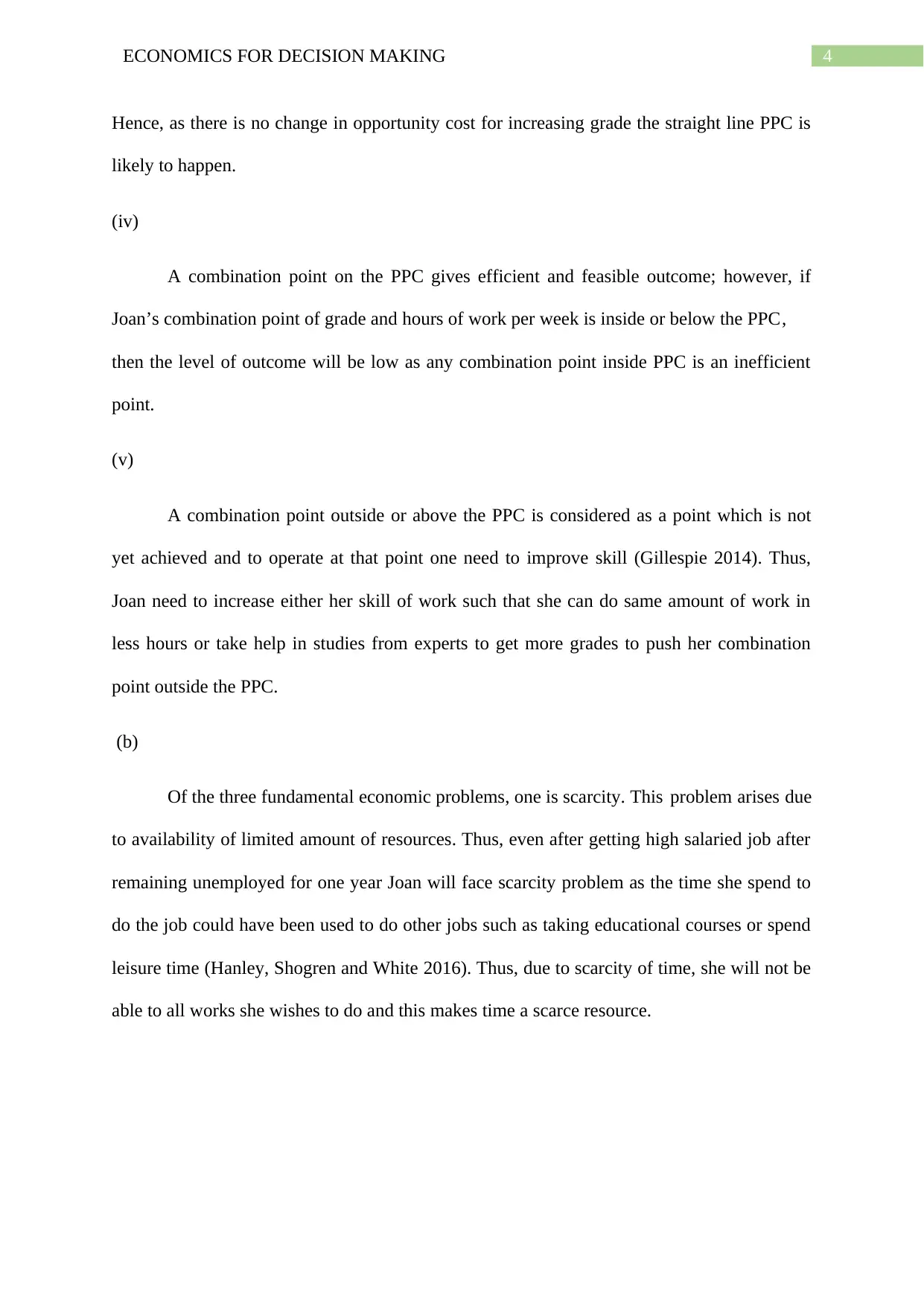
4ECONOMICS FOR DECISION MAKING
Hence, as there is no change in opportunity cost for increasing grade the straight line PPC is
likely to happen.
(iv)
A combination point on the PPC gives efficient and feasible outcome; however, if
Joan’s combination point of grade and hours of work per week is inside or below the PPC,
then the level of outcome will be low as any combination point inside PPC is an inefficient
point.
(v)
A combination point outside or above the PPC is considered as a point which is not
yet achieved and to operate at that point one need to improve skill (Gillespie 2014). Thus,
Joan need to increase either her skill of work such that she can do same amount of work in
less hours or take help in studies from experts to get more grades to push her combination
point outside the PPC.
(b)
Of the three fundamental economic problems, one is scarcity. This problem arises due
to availability of limited amount of resources. Thus, even after getting high salaried job after
remaining unemployed for one year Joan will face scarcity problem as the time she spend to
do the job could have been used to do other jobs such as taking educational courses or spend
leisure time (Hanley, Shogren and White 2016). Thus, due to scarcity of time, she will not be
able to all works she wishes to do and this makes time a scarce resource.
Hence, as there is no change in opportunity cost for increasing grade the straight line PPC is
likely to happen.
(iv)
A combination point on the PPC gives efficient and feasible outcome; however, if
Joan’s combination point of grade and hours of work per week is inside or below the PPC,
then the level of outcome will be low as any combination point inside PPC is an inefficient
point.
(v)
A combination point outside or above the PPC is considered as a point which is not
yet achieved and to operate at that point one need to improve skill (Gillespie 2014). Thus,
Joan need to increase either her skill of work such that she can do same amount of work in
less hours or take help in studies from experts to get more grades to push her combination
point outside the PPC.
(b)
Of the three fundamental economic problems, one is scarcity. This problem arises due
to availability of limited amount of resources. Thus, even after getting high salaried job after
remaining unemployed for one year Joan will face scarcity problem as the time she spend to
do the job could have been used to do other jobs such as taking educational courses or spend
leisure time (Hanley, Shogren and White 2016). Thus, due to scarcity of time, she will not be
able to all works she wishes to do and this makes time a scarce resource.
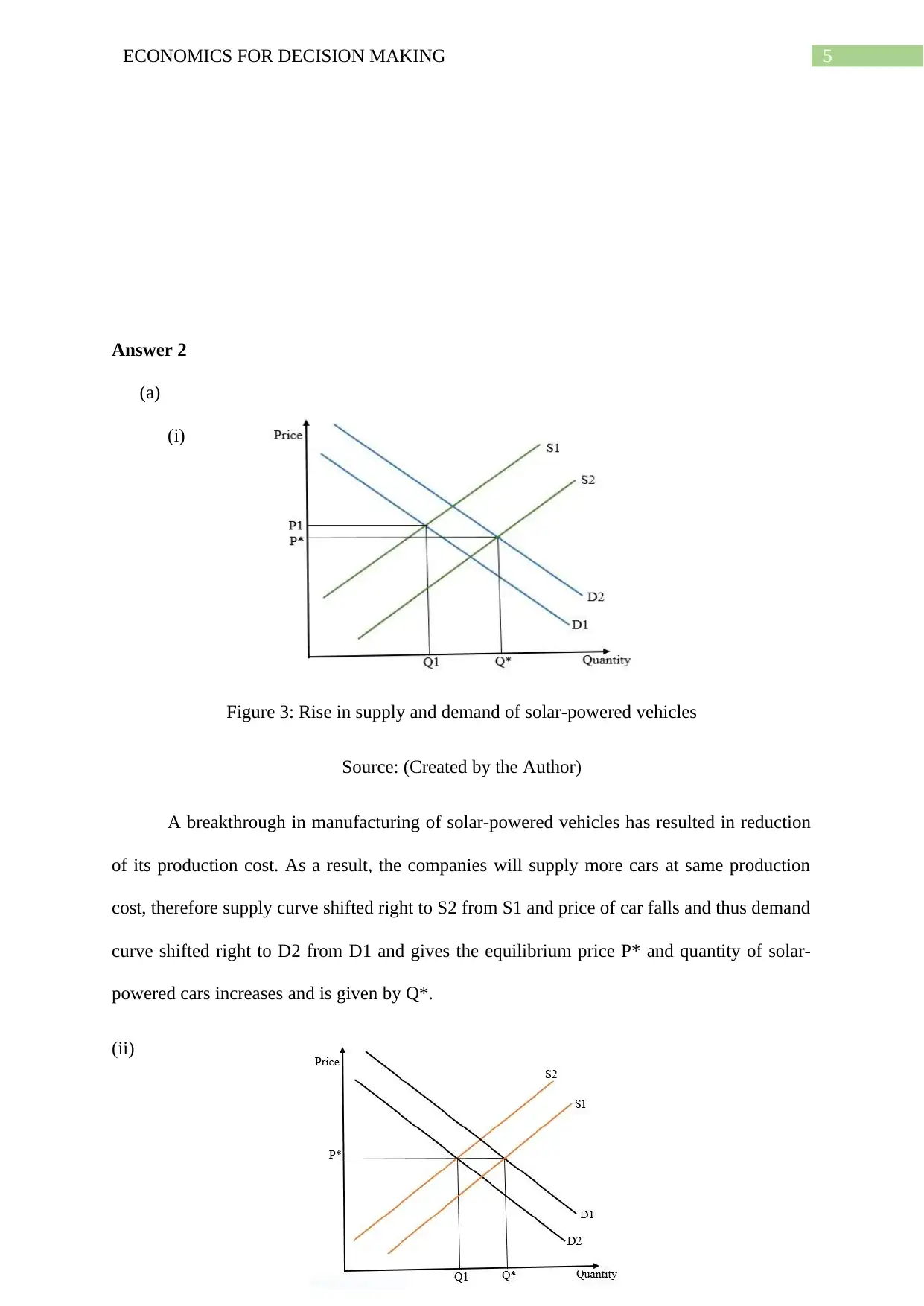
5ECONOMICS FOR DECISION MAKING
Answer 2
(a)
(i)
Figure 3: Rise in supply and demand of solar-powered vehicles
Source: (Created by the Author)
A breakthrough in manufacturing of solar-powered vehicles has resulted in reduction
of its production cost. As a result, the companies will supply more cars at same production
cost, therefore supply curve shifted right to S2 from S1 and price of car falls and thus demand
curve shifted right to D2 from D1 and gives the equilibrium price P* and quantity of solar-
powered cars increases and is given by Q*.
(ii)
Answer 2
(a)
(i)
Figure 3: Rise in supply and demand of solar-powered vehicles
Source: (Created by the Author)
A breakthrough in manufacturing of solar-powered vehicles has resulted in reduction
of its production cost. As a result, the companies will supply more cars at same production
cost, therefore supply curve shifted right to S2 from S1 and price of car falls and thus demand
curve shifted right to D2 from D1 and gives the equilibrium price P* and quantity of solar-
powered cars increases and is given by Q*.
(ii)
⊘ This is a preview!⊘
Do you want full access?
Subscribe today to unlock all pages.

Trusted by 1+ million students worldwide

6ECONOMICS FOR DECISION MAKING
Figure 4: Fall in supply and demand of conventional cars
Source: (Created by the Author)
The decline in the price of solar-powered vehicles increases the market share of solar-
powered vehicle manufacturing companies and thereby decreases the market share of
conventional vehicles since the total volume of the market is same. As a result, the demand
for conventional vehicles falls and shift in demand curve occurs to the left from D1 to D2,
realizing the fall in demand the conventional vehicle manufacturers reduce supply causing
shift in supply curve from S1 to S2. Thus, the market shrinks to Q1 from Q*.
(b)
Figure 5: Policy of minimum price below market price
Source: (Created by the Author)
The government has set minimum price at Pm for solar-powered vehicles to raise
production and sales of the vehicles (McLaughlin et al. 2014). However, the price Pm is lower
than the free market price P*. It is known from microeconomic theory that under free market
conditions price do not go below P*, which is alternatively known as price under perfect
competition. The consumers are always willing to purchase at perfect competition price as it
Figure 4: Fall in supply and demand of conventional cars
Source: (Created by the Author)
The decline in the price of solar-powered vehicles increases the market share of solar-
powered vehicle manufacturing companies and thereby decreases the market share of
conventional vehicles since the total volume of the market is same. As a result, the demand
for conventional vehicles falls and shift in demand curve occurs to the left from D1 to D2,
realizing the fall in demand the conventional vehicle manufacturers reduce supply causing
shift in supply curve from S1 to S2. Thus, the market shrinks to Q1 from Q*.
(b)
Figure 5: Policy of minimum price below market price
Source: (Created by the Author)
The government has set minimum price at Pm for solar-powered vehicles to raise
production and sales of the vehicles (McLaughlin et al. 2014). However, the price Pm is lower
than the free market price P*. It is known from microeconomic theory that under free market
conditions price do not go below P*, which is alternatively known as price under perfect
competition. The consumers are always willing to purchase at perfect competition price as it
Paraphrase This Document
Need a fresh take? Get an instant paraphrase of this document with our AI Paraphraser
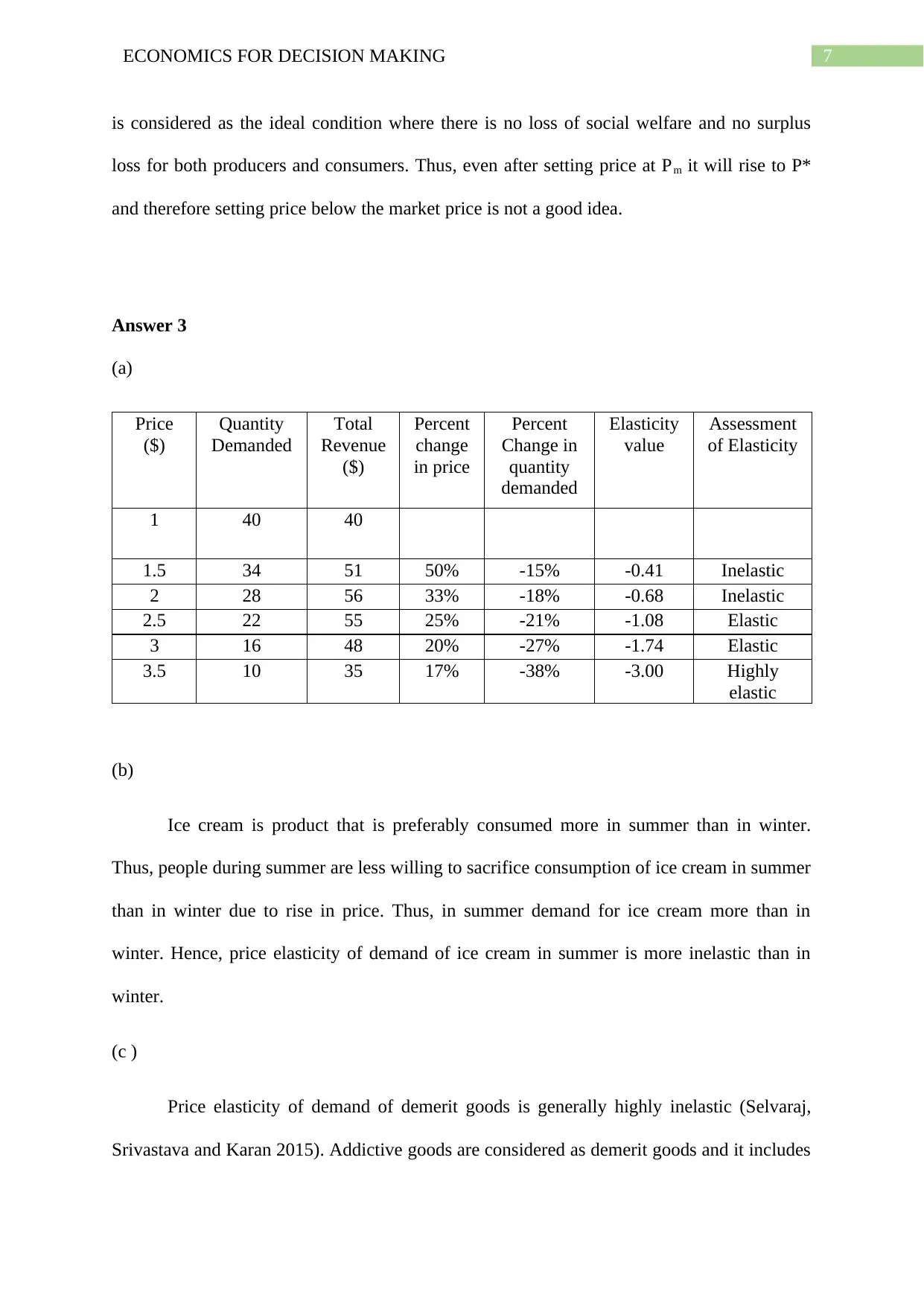
7ECONOMICS FOR DECISION MAKING
is considered as the ideal condition where there is no loss of social welfare and no surplus
loss for both producers and consumers. Thus, even after setting price at Pm it will rise to P*
and therefore setting price below the market price is not a good idea.
Answer 3
(a)
Price
($)
Quantity
Demanded
Total
Revenue
($)
Percent
change
in price
Percent
Change in
quantity
demanded
Elasticity
value
Assessment
of Elasticity
1 40 40
1.5 34 51 50% -15% -0.41 Inelastic
2 28 56 33% -18% -0.68 Inelastic
2.5 22 55 25% -21% -1.08 Elastic
3 16 48 20% -27% -1.74 Elastic
3.5 10 35 17% -38% -3.00 Highly
elastic
(b)
Ice cream is product that is preferably consumed more in summer than in winter.
Thus, people during summer are less willing to sacrifice consumption of ice cream in summer
than in winter due to rise in price. Thus, in summer demand for ice cream more than in
winter. Hence, price elasticity of demand of ice cream in summer is more inelastic than in
winter.
(c )
Price elasticity of demand of demerit goods is generally highly inelastic (Selvaraj,
Srivastava and Karan 2015). Addictive goods are considered as demerit goods and it includes
is considered as the ideal condition where there is no loss of social welfare and no surplus
loss for both producers and consumers. Thus, even after setting price at Pm it will rise to P*
and therefore setting price below the market price is not a good idea.
Answer 3
(a)
Price
($)
Quantity
Demanded
Total
Revenue
($)
Percent
change
in price
Percent
Change in
quantity
demanded
Elasticity
value
Assessment
of Elasticity
1 40 40
1.5 34 51 50% -15% -0.41 Inelastic
2 28 56 33% -18% -0.68 Inelastic
2.5 22 55 25% -21% -1.08 Elastic
3 16 48 20% -27% -1.74 Elastic
3.5 10 35 17% -38% -3.00 Highly
elastic
(b)
Ice cream is product that is preferably consumed more in summer than in winter.
Thus, people during summer are less willing to sacrifice consumption of ice cream in summer
than in winter due to rise in price. Thus, in summer demand for ice cream more than in
winter. Hence, price elasticity of demand of ice cream in summer is more inelastic than in
winter.
(c )
Price elasticity of demand of demerit goods is generally highly inelastic (Selvaraj,
Srivastava and Karan 2015). Addictive goods are considered as demerit goods and it includes
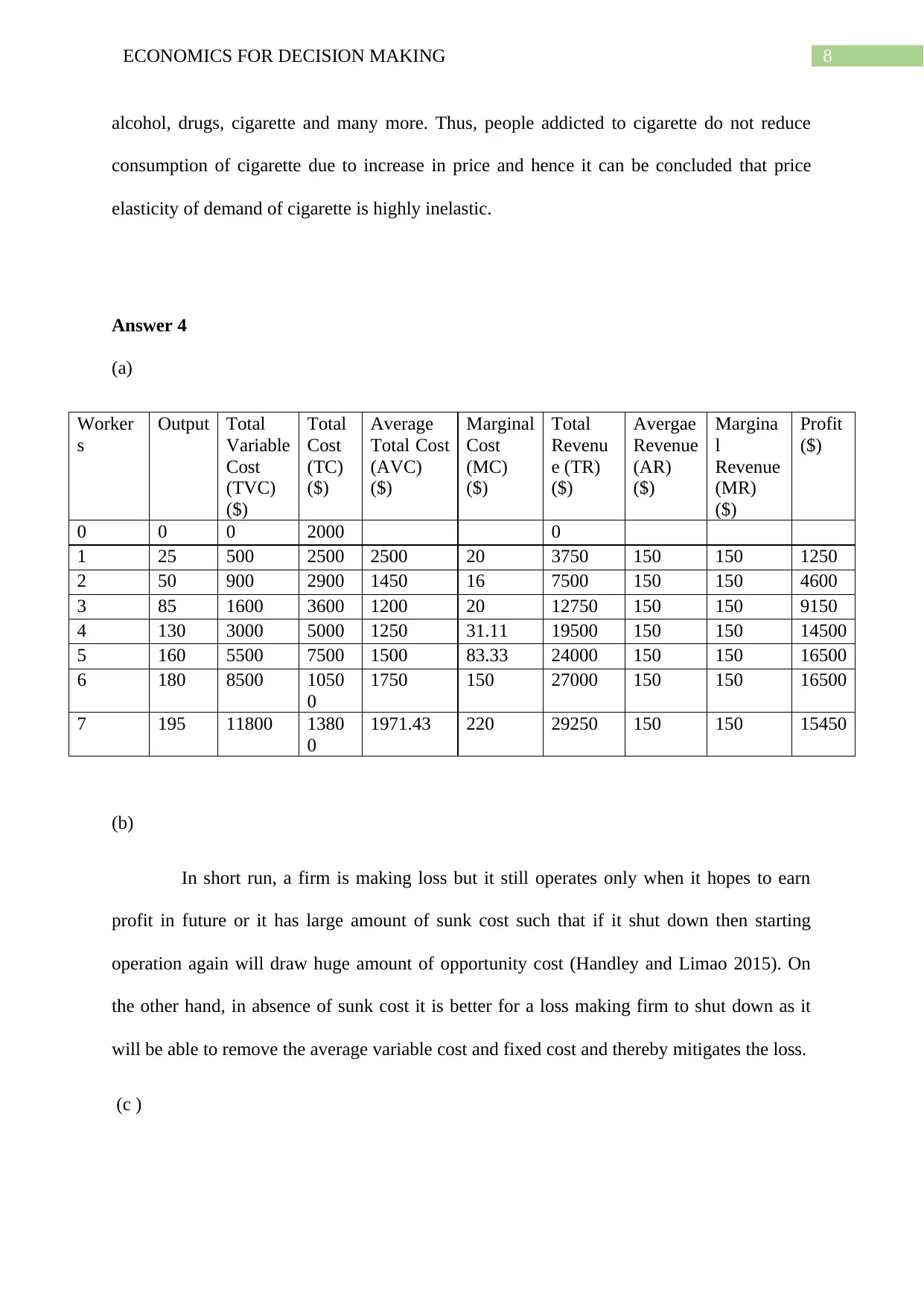
8ECONOMICS FOR DECISION MAKING
alcohol, drugs, cigarette and many more. Thus, people addicted to cigarette do not reduce
consumption of cigarette due to increase in price and hence it can be concluded that price
elasticity of demand of cigarette is highly inelastic.
Answer 4
(a)
Worker
s
Output Total
Variable
Cost
(TVC)
($)
Total
Cost
(TC)
($)
Average
Total Cost
(AVC)
($)
Marginal
Cost
(MC)
($)
Total
Revenu
e (TR)
($)
Avergae
Revenue
(AR)
($)
Margina
l
Revenue
(MR)
($)
Profit
($)
0 0 0 2000 0
1 25 500 2500 2500 20 3750 150 150 1250
2 50 900 2900 1450 16 7500 150 150 4600
3 85 1600 3600 1200 20 12750 150 150 9150
4 130 3000 5000 1250 31.11 19500 150 150 14500
5 160 5500 7500 1500 83.33 24000 150 150 16500
6 180 8500 1050
0
1750 150 27000 150 150 16500
7 195 11800 1380
0
1971.43 220 29250 150 150 15450
(b)
In short run, a firm is making loss but it still operates only when it hopes to earn
profit in future or it has large amount of sunk cost such that if it shut down then starting
operation again will draw huge amount of opportunity cost (Handley and Limao 2015). On
the other hand, in absence of sunk cost it is better for a loss making firm to shut down as it
will be able to remove the average variable cost and fixed cost and thereby mitigates the loss.
(c )
alcohol, drugs, cigarette and many more. Thus, people addicted to cigarette do not reduce
consumption of cigarette due to increase in price and hence it can be concluded that price
elasticity of demand of cigarette is highly inelastic.
Answer 4
(a)
Worker
s
Output Total
Variable
Cost
(TVC)
($)
Total
Cost
(TC)
($)
Average
Total Cost
(AVC)
($)
Marginal
Cost
(MC)
($)
Total
Revenu
e (TR)
($)
Avergae
Revenue
(AR)
($)
Margina
l
Revenue
(MR)
($)
Profit
($)
0 0 0 2000 0
1 25 500 2500 2500 20 3750 150 150 1250
2 50 900 2900 1450 16 7500 150 150 4600
3 85 1600 3600 1200 20 12750 150 150 9150
4 130 3000 5000 1250 31.11 19500 150 150 14500
5 160 5500 7500 1500 83.33 24000 150 150 16500
6 180 8500 1050
0
1750 150 27000 150 150 16500
7 195 11800 1380
0
1971.43 220 29250 150 150 15450
(b)
In short run, a firm is making loss but it still operates only when it hopes to earn
profit in future or it has large amount of sunk cost such that if it shut down then starting
operation again will draw huge amount of opportunity cost (Handley and Limao 2015). On
the other hand, in absence of sunk cost it is better for a loss making firm to shut down as it
will be able to remove the average variable cost and fixed cost and thereby mitigates the loss.
(c )
⊘ This is a preview!⊘
Do you want full access?
Subscribe today to unlock all pages.

Trusted by 1+ million students worldwide
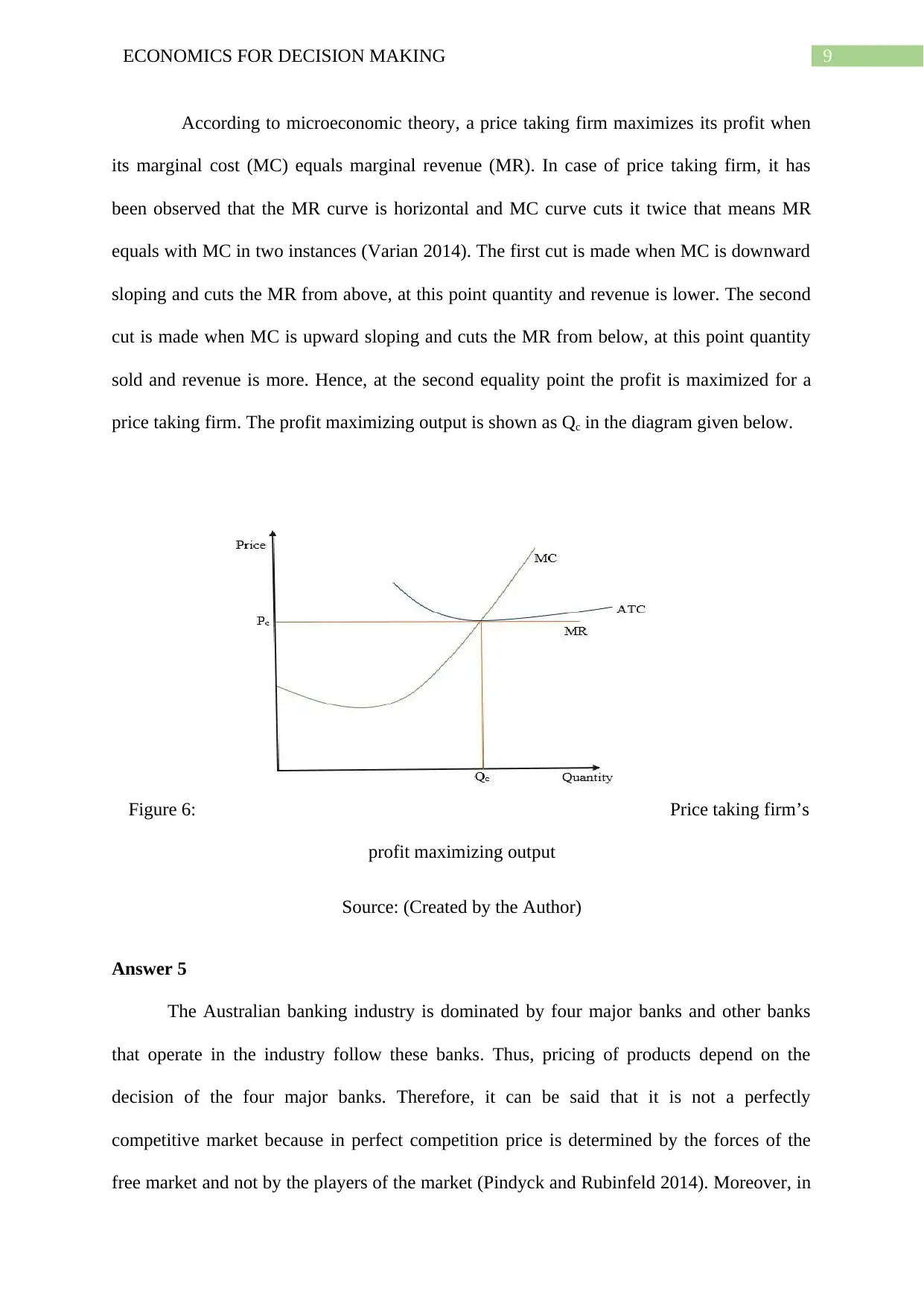
9ECONOMICS FOR DECISION MAKING
According to microeconomic theory, a price taking firm maximizes its profit when
its marginal cost (MC) equals marginal revenue (MR). In case of price taking firm, it has
been observed that the MR curve is horizontal and MC curve cuts it twice that means MR
equals with MC in two instances (Varian 2014). The first cut is made when MC is downward
sloping and cuts the MR from above, at this point quantity and revenue is lower. The second
cut is made when MC is upward sloping and cuts the MR from below, at this point quantity
sold and revenue is more. Hence, at the second equality point the profit is maximized for a
price taking firm. The profit maximizing output is shown as Qc in the diagram given below.
Figure 6: Price taking firm’s
profit maximizing output
Source: (Created by the Author)
Answer 5
The Australian banking industry is dominated by four major banks and other banks
that operate in the industry follow these banks. Thus, pricing of products depend on the
decision of the four major banks. Therefore, it can be said that it is not a perfectly
competitive market because in perfect competition price is determined by the forces of the
free market and not by the players of the market (Pindyck and Rubinfeld 2014). Moreover, in
According to microeconomic theory, a price taking firm maximizes its profit when
its marginal cost (MC) equals marginal revenue (MR). In case of price taking firm, it has
been observed that the MR curve is horizontal and MC curve cuts it twice that means MR
equals with MC in two instances (Varian 2014). The first cut is made when MC is downward
sloping and cuts the MR from above, at this point quantity and revenue is lower. The second
cut is made when MC is upward sloping and cuts the MR from below, at this point quantity
sold and revenue is more. Hence, at the second equality point the profit is maximized for a
price taking firm. The profit maximizing output is shown as Qc in the diagram given below.
Figure 6: Price taking firm’s
profit maximizing output
Source: (Created by the Author)
Answer 5
The Australian banking industry is dominated by four major banks and other banks
that operate in the industry follow these banks. Thus, pricing of products depend on the
decision of the four major banks. Therefore, it can be said that it is not a perfectly
competitive market because in perfect competition price is determined by the forces of the
free market and not by the players of the market (Pindyck and Rubinfeld 2014). Moreover, in
Paraphrase This Document
Need a fresh take? Get an instant paraphrase of this document with our AI Paraphraser
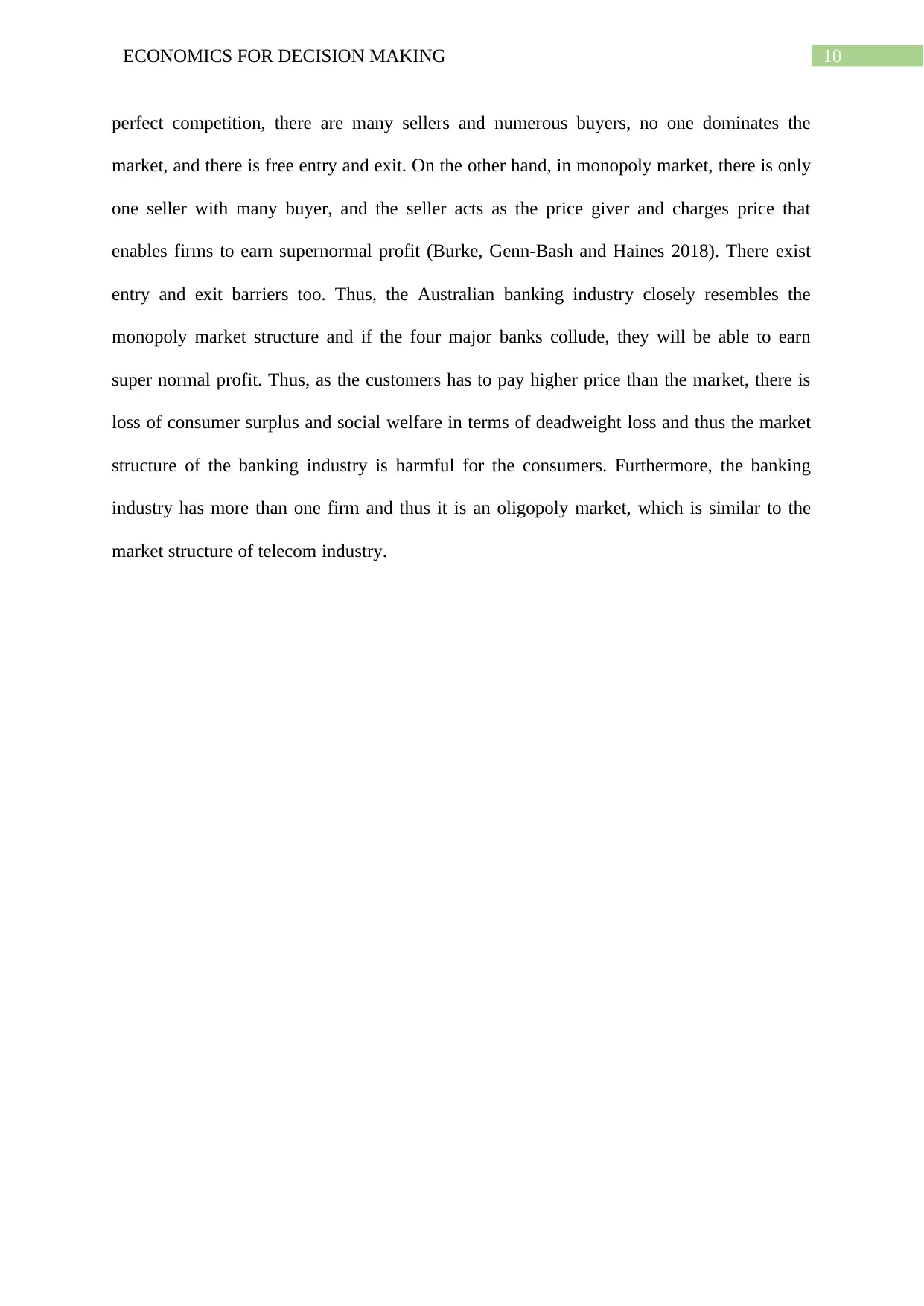
10ECONOMICS FOR DECISION MAKING
perfect competition, there are many sellers and numerous buyers, no one dominates the
market, and there is free entry and exit. On the other hand, in monopoly market, there is only
one seller with many buyer, and the seller acts as the price giver and charges price that
enables firms to earn supernormal profit (Burke, Genn-Bash and Haines 2018). There exist
entry and exit barriers too. Thus, the Australian banking industry closely resembles the
monopoly market structure and if the four major banks collude, they will be able to earn
super normal profit. Thus, as the customers has to pay higher price than the market, there is
loss of consumer surplus and social welfare in terms of deadweight loss and thus the market
structure of the banking industry is harmful for the consumers. Furthermore, the banking
industry has more than one firm and thus it is an oligopoly market, which is similar to the
market structure of telecom industry.
perfect competition, there are many sellers and numerous buyers, no one dominates the
market, and there is free entry and exit. On the other hand, in monopoly market, there is only
one seller with many buyer, and the seller acts as the price giver and charges price that
enables firms to earn supernormal profit (Burke, Genn-Bash and Haines 2018). There exist
entry and exit barriers too. Thus, the Australian banking industry closely resembles the
monopoly market structure and if the four major banks collude, they will be able to earn
super normal profit. Thus, as the customers has to pay higher price than the market, there is
loss of consumer surplus and social welfare in terms of deadweight loss and thus the market
structure of the banking industry is harmful for the consumers. Furthermore, the banking
industry has more than one firm and thus it is an oligopoly market, which is similar to the
market structure of telecom industry.
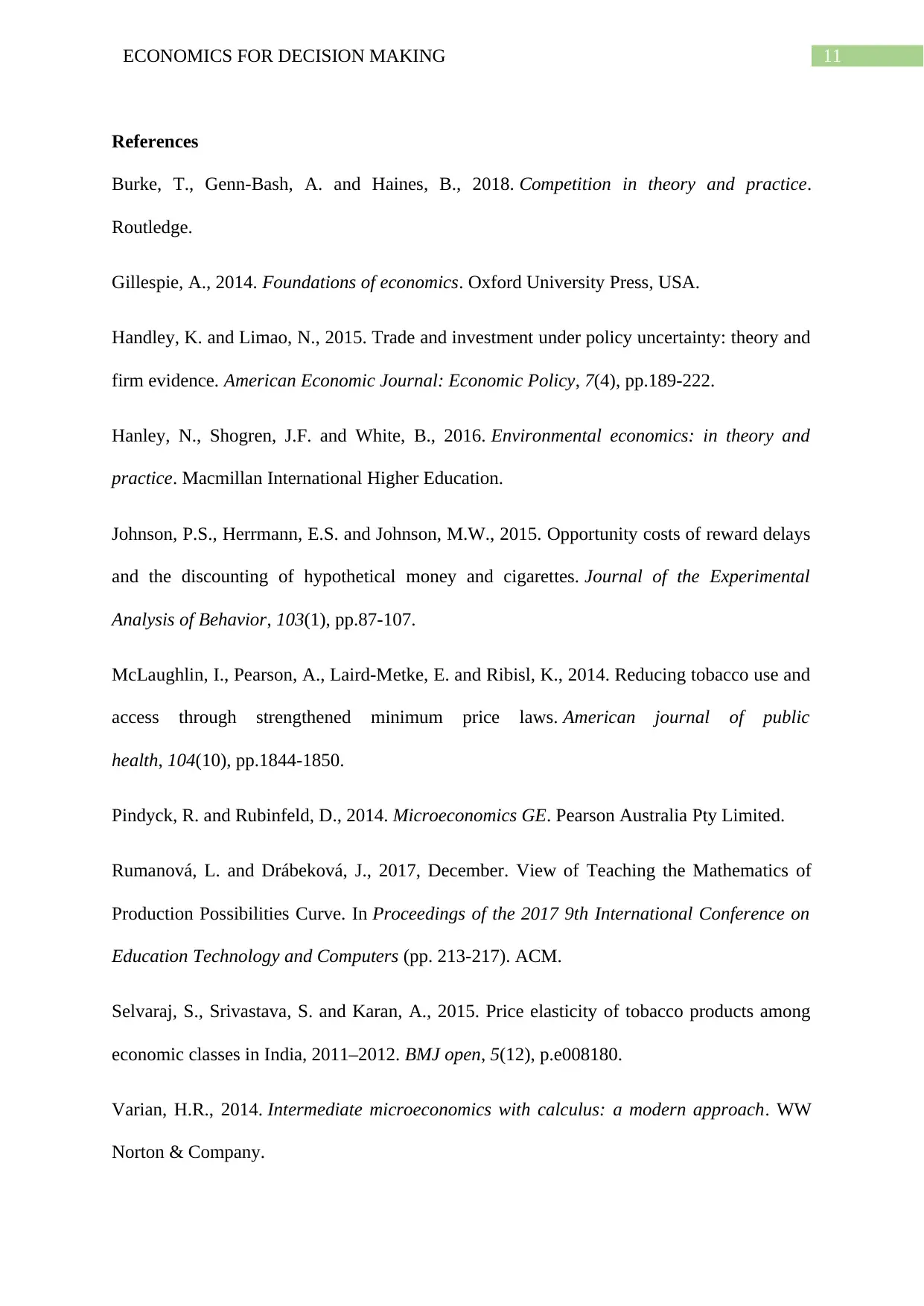
11ECONOMICS FOR DECISION MAKING
References
Burke, T., Genn-Bash, A. and Haines, B., 2018. Competition in theory and practice.
Routledge.
Gillespie, A., 2014. Foundations of economics. Oxford University Press, USA.
Handley, K. and Limao, N., 2015. Trade and investment under policy uncertainty: theory and
firm evidence. American Economic Journal: Economic Policy, 7(4), pp.189-222.
Hanley, N., Shogren, J.F. and White, B., 2016. Environmental economics: in theory and
practice. Macmillan International Higher Education.
Johnson, P.S., Herrmann, E.S. and Johnson, M.W., 2015. Opportunity costs of reward delays
and the discounting of hypothetical money and cigarettes. Journal of the Experimental
Analysis of Behavior, 103(1), pp.87-107.
McLaughlin, I., Pearson, A., Laird-Metke, E. and Ribisl, K., 2014. Reducing tobacco use and
access through strengthened minimum price laws. American journal of public
health, 104(10), pp.1844-1850.
Pindyck, R. and Rubinfeld, D., 2014. Microeconomics GE. Pearson Australia Pty Limited.
Rumanová, L. and Drábeková, J., 2017, December. View of Teaching the Mathematics of
Production Possibilities Curve. In Proceedings of the 2017 9th International Conference on
Education Technology and Computers (pp. 213-217). ACM.
Selvaraj, S., Srivastava, S. and Karan, A., 2015. Price elasticity of tobacco products among
economic classes in India, 2011–2012. BMJ open, 5(12), p.e008180.
Varian, H.R., 2014. Intermediate microeconomics with calculus: a modern approach. WW
Norton & Company.
References
Burke, T., Genn-Bash, A. and Haines, B., 2018. Competition in theory and practice.
Routledge.
Gillespie, A., 2014. Foundations of economics. Oxford University Press, USA.
Handley, K. and Limao, N., 2015. Trade and investment under policy uncertainty: theory and
firm evidence. American Economic Journal: Economic Policy, 7(4), pp.189-222.
Hanley, N., Shogren, J.F. and White, B., 2016. Environmental economics: in theory and
practice. Macmillan International Higher Education.
Johnson, P.S., Herrmann, E.S. and Johnson, M.W., 2015. Opportunity costs of reward delays
and the discounting of hypothetical money and cigarettes. Journal of the Experimental
Analysis of Behavior, 103(1), pp.87-107.
McLaughlin, I., Pearson, A., Laird-Metke, E. and Ribisl, K., 2014. Reducing tobacco use and
access through strengthened minimum price laws. American journal of public
health, 104(10), pp.1844-1850.
Pindyck, R. and Rubinfeld, D., 2014. Microeconomics GE. Pearson Australia Pty Limited.
Rumanová, L. and Drábeková, J., 2017, December. View of Teaching the Mathematics of
Production Possibilities Curve. In Proceedings of the 2017 9th International Conference on
Education Technology and Computers (pp. 213-217). ACM.
Selvaraj, S., Srivastava, S. and Karan, A., 2015. Price elasticity of tobacco products among
economic classes in India, 2011–2012. BMJ open, 5(12), p.e008180.
Varian, H.R., 2014. Intermediate microeconomics with calculus: a modern approach. WW
Norton & Company.
⊘ This is a preview!⊘
Do you want full access?
Subscribe today to unlock all pages.

Trusted by 1+ million students worldwide
1 out of 12
Related Documents
Your All-in-One AI-Powered Toolkit for Academic Success.
+13062052269
info@desklib.com
Available 24*7 on WhatsApp / Email
![[object Object]](/_next/static/media/star-bottom.7253800d.svg)
Unlock your academic potential
Copyright © 2020–2025 A2Z Services. All Rights Reserved. Developed and managed by ZUCOL.




